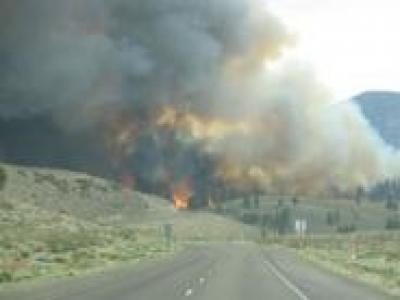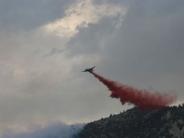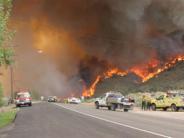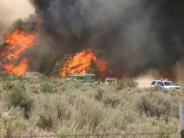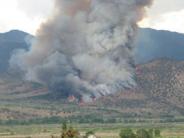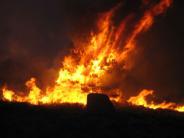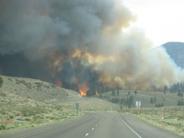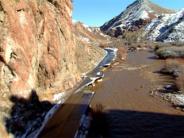Emergency Services
Office of Emergency Services (OES) and Emergency Operations Center (EOC)
The Mono County Code designates the Sheriff-Coroner as the County Director of Emergency Services. The mission of the Mono County Office of Emergency Services is to ensure the county is ready and able to mitigate against, prepare for, respond to, and recover from the effects of emergencies that threaten lives, property, and the environment.
The Mono County Office of Emergency Services coordinates the activities of all county departments relating to preparation and implementation of the county's Emergency Operations Plan (EOP). The Mono County Office of Emergency Services also coordinates the response efforts of local, state, and federal agencies to ensure maximum effect with minimum overlap and confusion.
Our partners in our emergency management effort consist of numerous agencies including: the Town of Mammoth Lakes, US Forest Service, Los Angeles Department of Water and Power, USGS, BLM, California Office of Emergency Services, California Highway Patrol, Caltrans, Mono County Fire Districts, USMC Mountain Warfare Training Center, Mammoth Unified School District, and Eastern Sierra Unified School District.
What is Emergency Management?
Emergency Management is a coordinated effort of all levels of government (local, state, and federal) working together with business and industry, community based organizations, and volunteers to effectively meet the challenges posed by all types of emergencies and disasters. Within an integrated emergency management framework, these entities assist citizens and their communities to prepare for, respond to, recover from, and eliminate or mitigate the effects of natural, civil, and technological emergencies and disasters. The primary mission of emergency management is to save lives, prevent injuries, and reduce property damage in a community as a result of all types of emergencies and disasters.
The current emergency management structure that exists in the United States has its origins in the civil defense efforts that arose after World War II in response to the possibility of nuclear attack. In the 1960's, civil defense began expanding and by the 1980's the focus had widened and moved away from civil defense only to the multi-hazard approach of emergency management that prevails today.
As a result of the events during the 1991 East Bay Hills fire, Senator Petris introduced SB 1841 (chaptered as Government Code Section 8607, effective January 1, 1993). This statute directs the Governor's Office of Emergency Services (State OES), in coordination with all interested state agencies with designated response roles in the state emergency plan and interested local emergency management agencies, to establish by regulation the Standardized Emergency Management System (SEMS). The framework of SEMS includes the Incident Command System (ICS), multi-agency or inter-agency coordination, Master Mutual Aid agreements and systems, and the Operational Area (OA) concept. SEMS is currently in use in all operational areas throughout California to assist emergency management in response to multi-agency and multi-jurisdictional emergencies and disasters.
What is the Operational Area (OA)?
Under SEMS, the Operational Area (OA) concept means an intermediate level of the State's emergency services organization which encompasses Mono County and all political subdivisions located within Mono County including special districts. The OA manages and/or coordinates information, resources, and priorities among local governments within the OA and serves as the coordination and communication link between the local government level and the regional level.
The Mono County Office of Emergency Services serves as the lead agency for the Mono County Operational Area. In this role, county OES coordinates emergency management provisions within the towns and communities, self-governed special districts, volunteer organizations, private industry, state and federal agencies, and others.
Mono County is the northernmost county in State OES's Southern Region. Southern Region is comprised of Mono County, Inyo County, San Bernardino County, Riverside County, Imperial County, San Diego County, Los Angeles County, Ventura County, Santa Barbara County, and San Luis Obispo County. In the event of a large scale disaster, the Mono County Operational Area has the ability to draw resources and assistance from all of the counties within Southern Region.
Preparing for Emergencies
What you can do to help yourself: Know what threats are prevalent to your area. In Mono County, we face danger from wildfires, earthquakes, floods, volcanic eruptions, avalanches, heavy snow, and other weather related conditions.
Here are a few tips to help prepare for emergencies (documents on these tips can be found at the bottom of page):
- Have a Family Emergency Plan
- Have an Emergency Kit
- Preparing your children
- Preparing those with disabilities
- Plan for your pets
- Plan for your horses
- Plan for your livestock
- Be self-sufficient for a minimum of 72-hours
- If your primary heat source is powered by electricity, invest in a stand-by generator in case the power goes out.
Have an Evacuation Plan
Evacuation orders are issued by local governments when an emergency occurs or may happen. If possible, the orders will be broadcasted over the Emergency Alert System. Other warning systems like Reverse 911 (CodeRED) may also be used. That's why it is very important to follow alert instructions. Follow travel routes outlined by authorities.
Prepare a plan in case authorities can't give you instructions right away. Plan where you'll go, how you'll get there, and what you'll bring with you.
Choose several destinations in different directions.
Get maps and figure out alternate routes.
If you don't have a car, figure out other types of transportation (such as asking to ride with a neighbor). If you have a car, keep it at least half a tank full of gas at all times.
EVACUATE IMMEDIATELY IF TOLD TO DO SO.
In case of evacuation:
If instructed, turn off the water, electricity, and gas at the main switches in your home.
Take your emergency kit.
Lock your house.
Personal Locator Beacon Information (PLB)
PLB's are part of the NOAA (National Oceanic and Atmospheric Administration) SARSAT (Search and Rescue Satellite Aided Tracking) system. When an individual (or group) is in distress, activating a PLB results in a 406MHz signal being transmitted. The distress signal is received by the SARSAT system which uses NOAA satellites in low-earth and geostationary orbits to detect and locate the source of the signal.
Initially, the geostationary satellites detect the signal and relay it to a network of ground stations and then ultimately to the U.S. Mission Control Center (USMCC) in Suitland, Maryland. The actual location of the transmitting PLB is then determined using doppler technology from the low-earth satellites which can take up to 45 minutes depending on the location of the PLB transmitter compared with the closest low-earth satellite.
Encoded in the transmitted signal is a serial number which is used to determine the registered owner of the PLB device. Some models of PLB's include and/or allow a GPS module. The GPS module is able to determine the PLB location by acquiring information from GPS satellites. Once the position is acquired using GPS satellites, the position coordinates are transmitted as part of the PLB signal thereby providing position information within minutes instead of the potential delay of 45 minutes. With the GPS information included in the transmission, the beacons location can be determined within feet instead of miles.
The USMCC provides the location information to the local Search and Rescue authorities. In addition to the 406MHz transmitted signal used by the SARSAT satellites, the PLB devices also transmit a 121.5MHz homing signal that is used by Search and Rescue teams to locate the person in distress once they get close to the location provided by the SARSAT system.
Carrying a PLB while on backcountry trips can provide an extra sense of security; however, there are a few things to think about prior to relying on a PLB for rescue in the event of an emergency.
The actual process of rescuing someone in a remote location takes considerable time and effort to complete, regardless of activation of a PLB. The PLB merely notifies others of where you are and of your emergency. Factors such as remoteness, weather, altitude and available rescuers all affect the time it takes to complete a search and rescue mission. DO NOT rely solely on PLB to save your life!! PLAN ahead and be prepared!!

